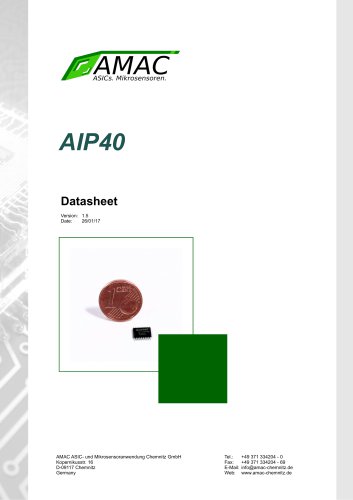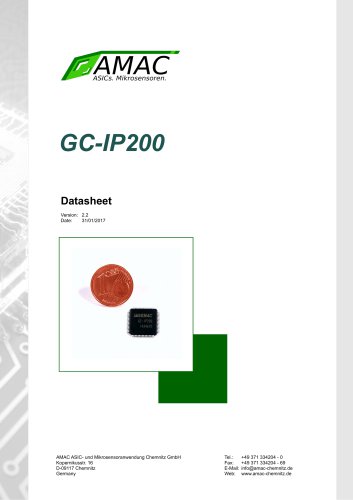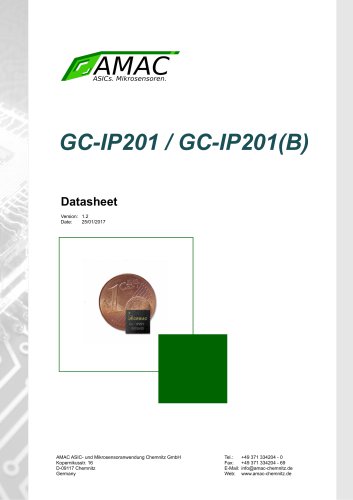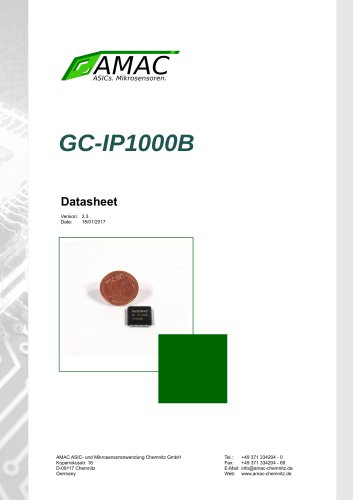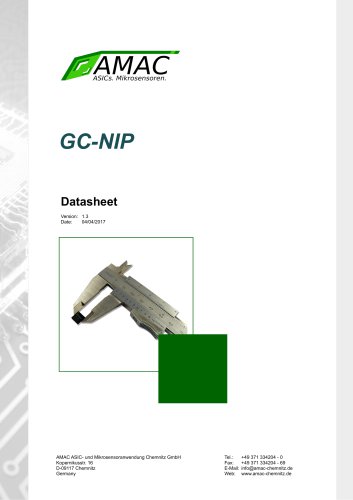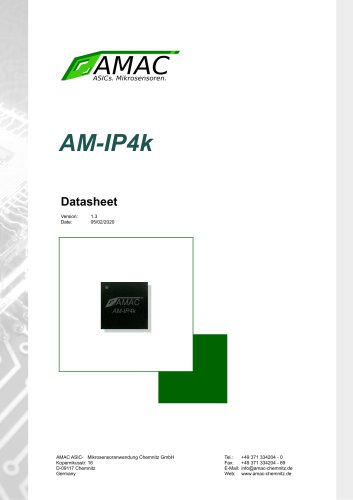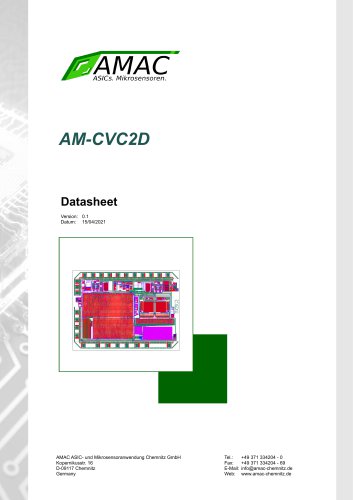
Catalog excerpts

Level shifter GC-LS Datasheet Version: 1.2 Date: 31/03/2017 AMAC ASIC- und Mikrosensoranwendung Chemnitz GmbH Kopernikusstr. 16 D-09117 Chemnitz Germany
Open the catalog to page 1
Revision Overview Date First version, preliminary version change to new AMAC document layout © Copyright 2018 AMAC ASIC- und Mikrosensoranwendung Chemnitz GmbH Subject to change without prior notice. Our policy is one of continuous improvement, and consequently the equipment may vary slightly from the description and specifications in this publication. The specifications, illustrations and descriptions provided in this documentation are not binding in detail. No part of this publication may be reproduced in any form, or by any means, without the prior written permission of AMAC ASIC- und...
Open the catalog to page 2
GC-LS Datasheet
Open the catalog to page 3
GC-LS Datasheet
Open the catalog to page 4
GC-LS Datasheet
Open the catalog to page 5
GC-LS Datasheet 1. Overview The four-channel level shifter circuit GC-LS is used for adjusting the voltage level between 5V encoders for distance or angle measurement and interpolation circuits with 3.3V operating voltage. Typically, standardized encoders and measuring bridges use a supply voltage of 5V and a common mode voltage of 2.5V. To connect these encoders with systems of 3.3V power supply, the conversion of the common mode voltage and amplitude is possible by using the GC-LS. Apart from the conversion of differential signals to differential ones also the conversion of single ended...
Open the catalog to page 6
GC-LS Datasheet 2. Features Adjustment of voltage level between 5V encoders for distance or angle measurement and interpolation circuits with 3.3V operating voltage integrated 3.3V voltage regulator for external circuit, linear controller can be switched off four channels differential or single-ended inputs high input impedance differential outputs 1,5 MHz cut-off frequency amplification 0 or -3,5dB; adjustable channel 4 can be switched off available as bare die or in QFN 32 (5x5x0,8 mm) 3. Description of Functions The IC contains four level shifters with differential inputs and...
Open the catalog to page 7
GC-LS Datasheet 4. Parameters Table 4: Absolute maximum ratings Symbol Characteristic value Analogue supply voltage Operating temperature Storage temperature Voltage at the analogue inputs Voltage at the configuration inputs Table 5: Operating conditions Symbol Characteristic value Analogue supply voltage Power consumption Operating temperature Table 6: Characteristic values Symbol Characteristic value Input impedance Common mode input voltage @(VIN < 1,0Vpp, Offset = 0V) Common mode rejection (@ f < 1kHz, SW11=1) Common mode output voltage @(VIN < 1,5Vpp, , SW11=0) Common mode output...
Open the catalog to page 8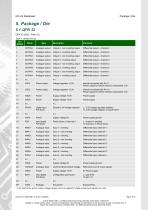
GC-LS Datasheet Analogue output Output 4 - non inverting output Differential output – channel 4 Analogue output Output 4 - inverting output Differential output – channel 4 Analogue output Output 3 - non inverting output Differential output – channel 3 Analogue output Output 3 - inverting output Differential output – channel 3 Analogue output Output 2 - non inverting output Differential output – channel 2 Analogue output Output 2 - inverting output Differential output – channel 2 Analogue output Output 1 - non inverting output Differential output – channel 1 Analogue output Output 1 -...
Open the catalog to page 9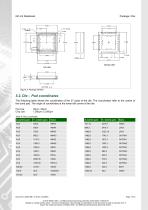
GC-LS Datasheet 5.2. Die – Pad coordinates The following table shows the coordinates of the 27 pads of the die. The coordinates refer to the centre of the bond pad. The origin of coordinates is the lower left corner of the die Pad size: Chip size: Table 8: Pad coordinates X_Centre (µm) Document: 44500-DB-1-2-E-GC-LS-AMAC © 2018 AMAC ASIC- und Mikrosensoranwendung Chemnitz GmbH Date: 01/03/2018 Subject to change without notice · Any kind of duplication, reprocessing and translation of this document as well as excerpts from it require the written permission of AMAC ASIC- und...
Open the catalog to page 10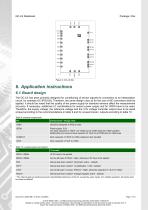
GC-LS Datasheet 6. Application instructions 6.1.Board design The GC-LS has been primarily designed for conditioning of sensor signals for connection to an interpolation circuit, for example GC-IP201(B). Therefore, the same design rules as for the use of A/D converters shall be applied. It should be noted that the quality of the power supply for standard sensors affect the measurement accuracy. If necessary, additional LC combinations for sensor power supply and for VDDA have to be used. Therefore, the supply voltage, the reference voltage and the 3.3V voltage controller output have to be...
Open the catalog to page 11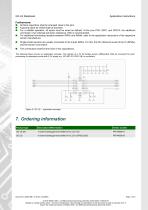
GC-LS Datasheet Application instructions Furthermore: All block capacitors shall be arranged close to the pins. A ground plane for VSSA shall be provided. For a reliable operation, all inputs must be wired as defined. At the pins PD4, SW11 and PD3V3, the additional connection of an external pull-down resistance (10k) is recommended. For additional terminating resistors between INPAx and INNAx, refer to the application instructions of the respective sensor manufacturer. Single-ended sensors are usually connected to the inputs INPAx. For this, the DC reference levels of the IC (INNAx) and the...
Open the catalog to page 12
GC-LS Datasheet Document: 44500-DB-1-2-E-GC-LS-AMAC © 2018 AMAC ASIC- und Mikrosensoranwendung Chemnitz GmbH Date: 01/03/2018 Subject to change without notice · Any kind of duplication, reprocessing and translation of this document as well as excerpts from it require the written permission of AMAC ASIC- und Mikrosensoranwendung Chemnitz GmbH.
Open the catalog to page 13All AMAC ASIC - und Mikrosensoranwendung Chemnitz GmbH catalogs and technical brochures
-
AIP40
19 Pages
-
GC-IP200
31 Pages
-
GC-IP201 / GC-IP201(B)
59 Pages
-
GC-IP1000B
33 Pages
-
GC-NIP
65 Pages
-
AM-IP4k
54 Pages
-
AM-CVC2D
36 Pages
-
GC-IP2000
51 Pages


